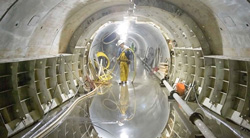

On some occasions, the objective of rehabilitation works is to increase the functionality of the underground structure or its capacity.
The most typical example would be the need of extra lanes of circulation for a road tunnel or the need of a larger diameter in order to accommodate bigger trains on a rail tunnel.
As complete closure of the tunnel is normally not possible, upgrading works are often challenging and need extensive and careful planning, logistics and specialized teams.
Even though upgrading works for tunnels demand a case-by-case analysis of the situation, some techniques that are often applied for enlarging the diameter of an existing tunnel are:
π Stage
Construction of a shelter with anti-shock material under which traffic runs. Over the shelter, works are undertaken following a number of steps composed of ground improvement, excavation, demolition of the old lining and erection of the new one.Crescent type tunnel cross-section
Enlarging works made with a large size excavator which operates using the existing line as a support for the enlarged tunnel, from which all operations of old lining demolition, rock support, new lining construction and muck removal are done.Tunnel Work Station
Totally automated works by means of an enlarging tunnel machine, which is a machine specifically conceived to carry out enlarging works in an automatic way, leaving space inside for the circulation of traffic. These machines are able to excavate, muck and place the new lining-support.Arch-cut method
Enlarging is made by excavating side drifts and using the old lining as a protection shield. When the old lining is demolished, a movable shield is installed to ensure traffic safety. In this case, the enlarging excavation is done with a special arch-shaped machine which can excavate and place the new lining.Flat stage method
This method uses a simple shield to separate vehicles from equipment. A movable working deck (flat stage) can be used also as a working platform for the excavator.
